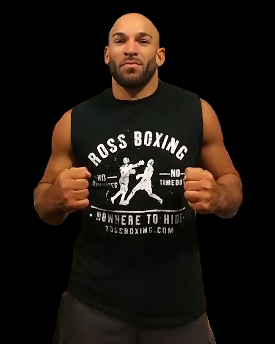Ross Enamait is Never Gymless
Ross Enamait has confessed to having a hard time staying still. It’s evident from a casual glance through his social media feed or from a review of his body of work over the years that he’s passionate about training hard and building ring deadly fighters who remain healthy enough to enjoy the fruits of their labor. His self described “low tech; high effect” approach is evident in his love for DIY home gym equipment that owes more to Home Depot than your local sporting goods store. Ross was gracious enough to grant me a forty-five minute window into his philosophy on building a business, strength and conditioning for fighters and training yourself without relying on the latest infomercial gadget.
You became a strength coach after injuries stopped you from continuing your career as a fighter. Talk about the process of going from realizing that your career was over to not only making the best of a bad situation but finding a way to still be connected to your passion.
Just to clarify now, I handled the strength and conditioning for the fighters, but I’m more of a boxing coach probably than a strength coach because I’m the boxing coach, but the strength and conditioning is something that I’m involved with as well. But, I’m still at the end of the day teaching the sport itself. But, as far as the transfer, going from fighting to coaching, I had bad hands— I never wanted to be a coach. It wasn’t something that I sought out to do. I had very bad hands and repeated fractures, and it was like my hands kept failing me, which I blame on some of my own ignorance as a youngster. I didn’t know what the hell I was doing or— I was a bit reckless you could say as young fighter to put it kindly. I didn’t want to leave the game. It was just like, to stay in the gym. I just started working with some of the other fighters. It was a way for me to stay involved while I wasn’t really sure what I was going to do with my life and one thing led to the other, and it ended up becoming probably the best decision that could have happened for me.
Do you think that your own mistakes are what make you so passionate about helping fighters?
It definitely helps. I was young, reckless getting into trouble outside of the gym. Certainly, I think it gives me a different set of eyes at least when you see a young fighter coming up because sometimes I see myself in someone else and you can hopefully steer them from making some of the mistakes maybe that I made twenty plus years ago.
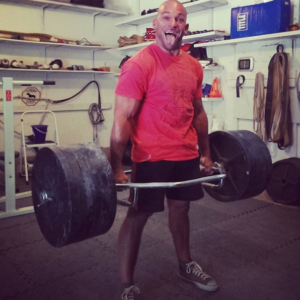 I think my first time seeing an image of you was when you were holding a trapbar deadlift at lockout and smiling at the camera. Do you remember that image and what was the story behind that? Was it a PR or were you just having a good day in the gym?
I think my first time seeing an image of you was when you were holding a trapbar deadlift at lockout and smiling at the camera. Do you remember that image and what was the story behind that? Was it a PR or were you just having a good day in the gym?
Ha ha! Yeah, I don’t even really remember, but we have fun in the gym. I couldn’t tell you, but we definitely keep it fun and talk some trash and get a little reckless. I’m all about working hard, but at the end of the day, we enjoy ourselves too because if you’re not having fun, the work starts to get a little bit monotonous.
Building A Business
You mention that motivation is overrated. Despite that, your training montages on YouTube were some of the most motivational clips I’ve ever seen. Did you create those clips simply to draw attention to your brand?
I think it’s like sometimes motivation might get a little bit confusing. You can inspire someone to maybe just give them an extra push. But, that’s different than relying on motivation to actually get up and go. Say I’m disciplined enough to put in the work, then maybe I see someone who’s doing something that I haven’t done yet. So, it says, oh, man I can do that too, or something. Maybe I get a little inspiration to push a little bit more. But at the end of the day, I still need to be disciplined enough to wake up on my own and put in the work. I think that’s where people get confused, They want to feel something before they start. The biggest problem of motivation is people want to feel motivation before they get going, when the real joy isn’t what you feel before you even have done anything. It’s like, you’ve put in the work regardless of how you feel. The joy comes after the fact. You’re done, you’ve roached the goal, you’ve won the fight or whatever it might be. Maybe to inspire someone to push a little bit more, to me, that’s different than just saying okay, here’s your daily motivation because you shouldn’t need this. People give motivation way too much credit.
Fighters tend to be self-motivated, at least the successful ones. But, do you find that occasionally, especially when emotional things happen, personal losses happen, that sometimes you have to go there and give them that the Mickey to Rocky speech?
I don’t know if it’s the Rocky speech, but people, as a professional fighter, sure, you need to be self-motivated. But, people don’t really see what goes on when you’re in training camp, so it’s like, 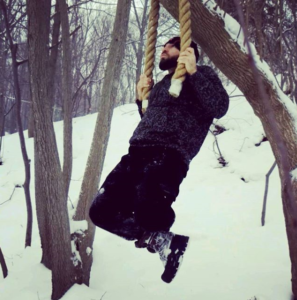 you’re in a 10 week camp. You’re busting your ass in the morning, during the day, at night, and then you’re six weeks in. You’ve been killing your body for six weeks. You look at the calendar and you still have a whole ‘nother month to go as far as you need to make the weight. You had a bad night of sleep, so anybody, there’s going to be times when you wake up and you’re like, man, I just don’t want to be there today. I don’t feel like putting in the sparring or whatever it might be.
you’re in a 10 week camp. You’re busting your ass in the morning, during the day, at night, and then you’re six weeks in. You’ve been killing your body for six weeks. You look at the calendar and you still have a whole ‘nother month to go as far as you need to make the weight. You had a bad night of sleep, so anybody, there’s going to be times when you wake up and you’re like, man, I just don’t want to be there today. I don’t feel like putting in the sparring or whatever it might be.
Obviously, an experienced fighter is experienced enough to get up and push himself, but at the same time, sometimes you definitely need to give them that extra push. Again, it’s not that they need motivation. It’s almost like they just need to be refreshed because camp can go on. It’s a lonely place. There’s not a lot of social interaction. You’re just there getting ready to fight. Like I said, a long camp, it’ll drag on. It can drive the strongest person mentally. It can drive you crazy at times.
You resist giving too much access into your life from a social media standpoint. That’s the polar opposite of many fitness industry professionals who seem to share everything they do.
I don’t know that you have to delve too much into your personal life.But, I think seeing is believing. Years ago, I remember I was on-line before YouTube even started. Back in the day, there wasn’t even really video. I uploaded my own videos. I think at the time it was all phone modem so it was all slow and to watch a video it would take you an hour just to watch five minutes. But, people at that time, there was claims of who could do this and that because nobody had to prove anything because it was no videos.
Obviously, that’s changed now. I think the most important thing would be to share content that’s relevant to what you’re actually doing.
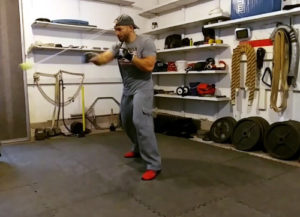 What would you say to someone who says it’s all well and good for an established coach to post less frequently but that to get to your level, it’s necessary to build a following?
What would you say to someone who says it’s all well and good for an established coach to post less frequently but that to get to your level, it’s necessary to build a following?
If you’re trying to say, you can teach people to do X, well, you should be out there doing X, so, it’s just not talk. You can demonstrate what you’re doing. But, as far as here’s what I had for breakfast, and here’s who I am, it’s like I think people get too carried away with that. People aren’t visiting you to see what you had for breakfast. They’re trying to get something useful, some content that they can go take with them and apply in their own life in some way, whether it’s an exercise idea, or some inspiration, or whatever it might be.
Conventional marketing wisdom says you have to engage with your target market on social media or you lose them to the competition. But it seems that the caliber of athlete who would seek you out isn’t searching for coaches on Snapchat or Instagram. How did you build the reputation that led to coaching world champions?
Obviously, it’s great to establish yourself online, but at the same time, people get too caught up in the online world. You got to do something off-line. The Internet isn’t everything. I like to think I don’t need the Internet. It’s fun to interact with people around the world, but at the same time, I still to this day view my own blog and what not as more of a hobby. I’d much rather be coaching real athletes than interacting with people on a blog. I think if you want to establish yourself, go do some real work off-line, and then use the on-line aspect to market yourself and maybe to expand your business, but don’t rely solely on it. There’s so many coaches nowadays who live on-line, who’ve never coached anybody. They’ve never done anything. It’s all imaginary.
How big a role do you think writing for outlets like Men’s Fitness, Men’s Health and Bodybuilding.com played in helping you build your credibility? As a freelancer, I understand that you don’t start out writing for big magazines. You have to develop your ability to pitch articles and develop a reputation before anyone will bring you on as a columnist. What were some keys in developing yourself as a fitness writer? Because that’s not a skill that every strength coach or fitness trainer has( hence the popularity of ghostwriting fitness articles).
You’re probably talking ten years back. I’m sure it was useful. It probably is a good idea to write for some of those bigger sites. I haven’t done it in so long, but obviously any chance you can have to get your image and your material out there to a broader audience is obviously going to be time well spent. I think it’s a great idea to do it.
get your image and your material out there to a broader audience is obviously going to be time well spent. I think it’s a great idea to do it.
Combat sports are one of the few places where the apprenticeship model is still honored. People want to know who you trained under more than they want to see your exercise physiology degree. For someone who wants to break into strength and conditioning for fighters, is it better to apprentice yourself to an established, respected mentor and spend time learning the trade from them craft rather than spending time on earning a degree or does a degree have some value?
I think my own situation might be a little bit unique from maybe the traditional course just because I was already in the gym, so when I stopped fighting and started working on people, I didn’t even have to leave. I was in the same gym, and then I started working with fighters that I had already known and competed with on the same team as an amateur. I don’t have to start from scratch and try to establish who I was. I had people that we had known each other for years already. Going from fighter to coach, it was a seamless transfer, whereas if I’m starting out from scratch, I don’t know if it happens the same way.
I ask because if you apply to work at a boxing gym or MMA school with no experience, you might start out as the custodian if that job isn’t already held by an aspiring fighter trading work for training. Do you think that today’s microwave society hinders coaches from learning the valuable lessons you only get by working your way up from the bottom?
Yeah, it’s like there’s not a quick path to get there. It’s like you got to pay your dues. You got to go in there and you have to learn the trade. There’s really no other way to do that, but being in the gym. Again, that’s what the problems are with the world today. Everyone wants everything done online. But, I always tell people, “Imagine if you were going to a dentist, who’s like, well, I’m not really a dentist in the real world. I’m just a dentist online. It’s like, I don’t want him touching my mouth. Or a surgeon who only blogs. “What do you mean, you don’t actually do surgeries?” But, that’s how in today’s world— there’s coaches who don’t actually coach. They’re online. That’s all they do. If you want to get involved in the boxing game, you got to go to the boxing gym. It can be an intimidating place to start, come walking in the doors for the first time, I get it. But, that’s one of the reasons it’s not for everybody. You have to be willing to suck it up and go in there and pay your dues.
Training Philosophy
Where do you normally train your fighters?
It depends. We were in camp with [former heavyweight champion] Vladimir Klitzchko, back it was probably like ten plus years ago where he’d be going all over the world. We were in Florida with him. But, typically speaking, we’ll train local here in Connecticut.
How about as the fight gets closer? Do you take your fighters away from their normal environment when they have a fight coming up to minimize distractions?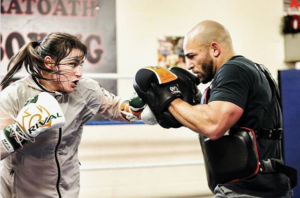
Yeah, it depends. I have a fighter from Ireland [WBA World Lightweight Champion Katie Taylor ed.] but she comes to have training camp in Connecticut. She’s away from her own environment setting, the distractions, which could be nice. It’s nice to be able to just get locked into training without being distracted by some fans or media or whatever it might be. You’re locked into the training and that’s all that matters.
I asked you that because, one of the things that people work out at home is, especially when they first start doing it, they feel like they need to almost apologize for training at home instead of getting a gym membership, like they’re not dedicated. I actually made a shirt that says, “I own the best gym in town!” You’re away from all the distractions. You’re away from all the weirdness of the gym. I talk about how fighters in the past, Muhammad Ali, Jack Dempsey, all these guys, Jack Johnson, all of them would go away and they would get away from their normal environment, where for that period of time while they’re training, that there’s nothing there but training. You have a microcosm of that in your home. Go down to your garage, out the back or whatever, turn off everything else, unplug and just be there for that moment, that time that’s dedicated to you.
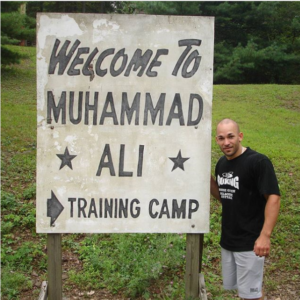 Just using Ali as an example, Ali used to go to Deer Lake, Pennsylvania, a lot of his camps were in Pennsylvania. We actually had a camp in Deer Lake in the same cabin where Muhammad Ali stayed. This was probably back in 2009. Let me tell you something. There’s nothing there. It was such a boring place where we were, we would take trips to Wal-Mart in the middle of the day, which is a 20 minute ride just to walk around the aisles because there’s literally nothing to do out there. There’s no fancy equipment. People have it in their minds that they need these big fancy facilities. Muhammad Ali is one of the best fighters in the history of the world, and he trained out in the woods of Deer Lake, Pennsylvania.
Just using Ali as an example, Ali used to go to Deer Lake, Pennsylvania, a lot of his camps were in Pennsylvania. We actually had a camp in Deer Lake in the same cabin where Muhammad Ali stayed. This was probably back in 2009. Let me tell you something. There’s nothing there. It was such a boring place where we were, we would take trips to Wal-Mart in the middle of the day, which is a 20 minute ride just to walk around the aisles because there’s literally nothing to do out there. There’s no fancy equipment. People have it in their minds that they need these big fancy facilities. Muhammad Ali is one of the best fighters in the history of the world, and he trained out in the woods of Deer Lake, Pennsylvania.
On your Instagram, you have an image of, I believe Jack Dempsey, and he’s holding a heavy rock over his head, right?
Oh, no, that’s Rocky Marciano.
Rocky Marciano, okay. There have been gyms since the 1800’s, probably before that. But, he could have been at a gym. Instead, he’s out lifting rocks for his training. Obviously there’s nothing else there. It’s rocks, an ax to cut some wood, and then go box.
Yeah, 100%. Well, someone asked me the other day … I saw a comment, something like, have you trained in your home gym the entire time? As if it was like how does that happen in a gym? When I get questions like that, I think back to Henry Rollins. “200 pounds is always going to be 200 pounds.” Lifting 200 pounds in your garage isn’t any different from lifting 200 pounds in some state-of-the-art gym. It’s still 200 pounds. It doesn’t matter where you lift.
You’re a big believer in low tech, high effect training tools. I especially like your DIY reverse hyper extension and tornado ball. 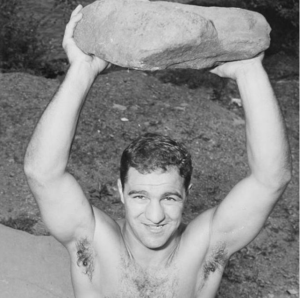 What is it that caused you to start with the low tech, high effect approach?
What is it that caused you to start with the low tech, high effect approach?
I don’t know what really caused me to do it. I grew up in a boxing gym, so we never had a whole lot as far as equipment. It’s like when you’ve been around that for most of your life, it’s what I’m used to. I wouldn’t say I necessarily found it. It’s just what I came up in. It’s just always been the way of life.
For example, you were training at home even as a young fighter and I believe you said you built a speed bag platform under the steps at your mom’s house is that right?
Correct. Just to correct you, I did training at home, but at the same time, as a fighter, we were in the boxing gym. It’s just that the boxing gym itself a lot of times is similar to what a home gym would be in the fact that there’s really not a lot of equipment. But, at the same time, if you’re going to fight, you obviously need to be in a gym where there’s proper sparring and what not and coaching. I just took the low-tech nature of the boxing gym and also replicated it at home to be able to do additional work.
I was in Chattanooga, Tennessee when I was training to fight and I just happened to run into former middleweight contender Jay Bell and I remember he had that typical, for the time, attitude that boxers shouldn’t lift weights, fighters shouldn’t lift weights because this makes you slow and it’s useless. You already did strength and conditioning as a fighter, but how did you decide to add weights into the mix?
That’s a tricky subject because there’s a lot of strong opinions for or against weights … I personally enjoy lifting weights. I land in the middle there because if you look at historically there are a lot of good fighters past and present who really don’t do a ton of strength training with weights. It’s tough to just say everybody needs to do this or shouldn’t be doing that. You’ve got examples of guys who have thrived on nothing more than calisthenics. You’ve got other guys, even back in the day like Evander Holyfield implemented a lot of free weights, so it’s not hard to do work with a lot of free weights. There’s been success stories on both sides. For me, as a boxing coach, I personally believe that sometimes the weights get too much attention whether you’re using them or whether you’re not. A lot of times strength and conditioning coaches try to make their own role out to be more important than it is. At the end of the day, if you can’t fight, it doesn’t matter if you’re lifting weights or not. It comes down to skill.
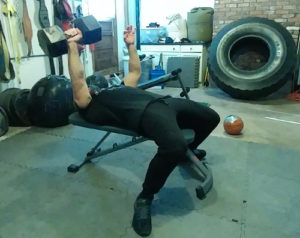 I think there is a proper way to include free wights, but at the same time, just because you lift weights isn’t going to make or break you as much as a lot of people maybe would lead you to believe that it does. But, personally, I think free weights can certainly be included. It’s just that it is a small piece of the puzzle though. You can’t spend too much time lifting because at the end of the day,whether it’s boxing or MMA, it is a skill sport and there’s a lot of skills you got to learn and a lot of time you get to spend in the ring.
I think there is a proper way to include free wights, but at the same time, just because you lift weights isn’t going to make or break you as much as a lot of people maybe would lead you to believe that it does. But, personally, I think free weights can certainly be included. It’s just that it is a small piece of the puzzle though. You can’t spend too much time lifting because at the end of the day,whether it’s boxing or MMA, it is a skill sport and there’s a lot of skills you got to learn and a lot of time you get to spend in the ring.
I’m actually working my way through Physical Training Simplified by Mark H. Berry. I’m not sure if you’re familiar with him. Physical Training Simplified, and he was The U.S. Olympic Weightlifting Team coach in 1932 and 1936. Anyway, in the book, he pointed out the importance of General Physical Preparedness (that’s not what he called it) for fighters. He talked at length about how the best fighters had a structure that was prepared for the demands of training before they started to train as fighters. It seems to me that one of the biggest problems is that people try to use weights for something it’s not. To me, unless your sport is a weight lifting sport, like power lifting or Olympic lifting, weight training is just general physical preparedness—
You basically need to be strong enough so that lack of strength isn’t a problem, if that makes sense.
Yeah! For the weight training that you do prescribe, do you do it more as like injury prevention, to work on the things that aren’t going to get addressed by normal boxing training. Pushups and pullups may not prevent biceps tears for example so you prescribe work with weights to prevent that?
Yeah, I would say to an extent, but also at the same time, as a boxing coach, there’s going to be fighters with entirely different styles. It’s like if I have someone whose game is rooted on inside fighting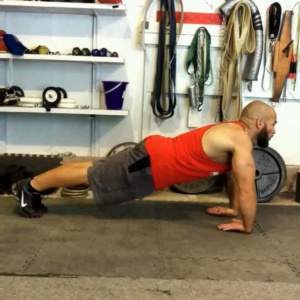 where we’re going to be in the pocket banging inside, banging on the ropes, we probably need to be a little stronger than we would be say if we were outside on our toes moving and sticking our jab avoiding the contact inside, and as we’re … A lot of times, when you talk about fighters it’s like all fighters should do this or all fighters should do that, but realistically, boxing or MMA is one of the most individualized sports in the world. Two fighters could have entirely different needs because they have different styles and temperaments as fighters. Like I said, if I have someone who’s an inside fighter, someone who’s banging, think of someone like a Ricky Hatton, they live inside, physical tough fighters, yeah, they’re going to need more rough physical work than a Sugar Ray Leonard who’s outside on this toes sticking his jab and moving. Again, I’m just not real big on generic everyone should be doing this or that. It really comes down to the individual, what they need, their own strengths and weaknesses.
where we’re going to be in the pocket banging inside, banging on the ropes, we probably need to be a little stronger than we would be say if we were outside on our toes moving and sticking our jab avoiding the contact inside, and as we’re … A lot of times, when you talk about fighters it’s like all fighters should do this or all fighters should do that, but realistically, boxing or MMA is one of the most individualized sports in the world. Two fighters could have entirely different needs because they have different styles and temperaments as fighters. Like I said, if I have someone who’s an inside fighter, someone who’s banging, think of someone like a Ricky Hatton, they live inside, physical tough fighters, yeah, they’re going to need more rough physical work than a Sugar Ray Leonard who’s outside on this toes sticking his jab and moving. Again, I’m just not real big on generic everyone should be doing this or that. It really comes down to the individual, what they need, their own strengths and weaknesses.
That answer shows how high caliber you are and where you are as a coach, because I actually just heard almost the exact same sentiments from Travis Mash, who was a powerlifting champion, and an Olympic weightlifting champion, and now he’s probably one of the best Olympic weightlifting coaches in the United States, maybe in the world. He says, when somebody’s a beginner, you can probably give them a cookie cutter program. But, as soon as you become more advanced, you need to tailor that program to that person, because otherwise, you’re either going to stagnate their progress, or you’re going to get them hurt.
Exactly, yeah.
One thing I like about your training style is that you show progressions. For example, you’re the only person I’ve ever encountered who demonstrated an effective way to go from the kneeling ab wheel rollout to the standing to the decline. When I first watched that video, it immediately clicked and seemed so obvious I couldn’t believe that I had never thought of it. Did you develop that method for yourself originally or was it through coaching your athletes?
No, that just came about. I was already doing standing rollouts and I forget which guy it was that we had. He was strong from the knees. Going from kneeling rollout to standing rollouts, it’s a huge difference. I actually said, “Man, we could just use the power ramp because it would be a lot easier to adjust the height,” just pull out the bar and you got a couple inch change. There’s definitely in my opinion, not a faster way to progress as far as achieving the standing rollout. Some people might do something similar with suspension trainer, but doing standing roll ups with a suspension trainer is not quite as difficult. It looks fancy, but it’s not as difficult as using an actual ab wheel.
I just read your article on the heavy bag as a conditioning tool. I like how you point out that although many people are aware that bag work is great for conditioning, they still tend to go for the latest gadgets rather than taking the time to squeeze every ounce of value they can out of things like a bag or jump rope. Why do you think the heavy bag gets overlooked so often by fitness professionals?
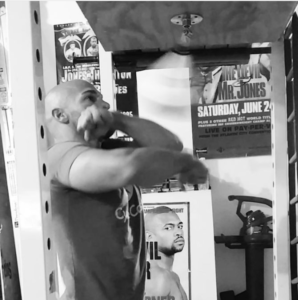 I don’t know. It’s like if it’s tough. I think a lot of times people are looking for an easier option. Hitting the bag is hard because the bag’s going to take it. You’re not going to beat the bag, no matter what you give, the bag is always going to be there to take what you’re giving it. I think a lot of times, people are just looking for something that’s going to deliver an easier way. That’s one of the things I’ve been saying for years, there is no easier way. I don’t care what you use, if you want to get something out of it, you’re going to have to bust your ass. The jump rope’s the same thing, you can get a jump rope for 10 bucks. World class fighters have used a jump rope for longer than we’ve all been alive, but still to this day, people want to find something else better than a rope. Maybe the rope is a little tricky because you actually have to learn how to skip it before you use it. I was skipping rope when I was eight years old. It’s not that difficult to learn how to skip rope, you just got to give it time.
I don’t know. It’s like if it’s tough. I think a lot of times people are looking for an easier option. Hitting the bag is hard because the bag’s going to take it. You’re not going to beat the bag, no matter what you give, the bag is always going to be there to take what you’re giving it. I think a lot of times, people are just looking for something that’s going to deliver an easier way. That’s one of the things I’ve been saying for years, there is no easier way. I don’t care what you use, if you want to get something out of it, you’re going to have to bust your ass. The jump rope’s the same thing, you can get a jump rope for 10 bucks. World class fighters have used a jump rope for longer than we’ve all been alive, but still to this day, people want to find something else better than a rope. Maybe the rope is a little tricky because you actually have to learn how to skip it before you use it. I was skipping rope when I was eight years old. It’s not that difficult to learn how to skip rope, you just got to give it time.
Having bad knees that keep me from running, I prefer bag work for conditioning. I especially like that you can get a good workout without having to leave the house, which is huge as the parent of a toddler. The only drawback is the noise. What would you recommend as a conditioning method that won’t interfere with nap time and still lets me stay nearby in case my daughter wakes up?
I think probably one of the quietest things you can do is a series of calisthenics. It’s different than say a full speed conditioner like a sprint, or hitting the bag or swinging a sledgehammer. But, even if you’re doing something as simple as going from squats to push-ups and you’re working at a quick pace— maybe it’s a little more strength and endurance than anything else. But, you can still get a decent session in without banging anything. That’s why I think it’s useful to have that base of calisthenics. When in doubt, you can always use your own body. People want to get all complicated with the calisthenics with all these fancy gymnastics moves. But, I always tell people if all the world woke up every day and did push-ups, pull-ups, squats, lunges, and something for the core, the world would be in pretty good shape.
Resistance Training and Combat Sports
Your training style seems like a throwback to the old days of physical culture when everyone who trained seriously wrestled, boxed, did calisthenics and gymnastics as well as train with weights. Who would you say were your mentors in strength and conditioning whether you actually trained with them or were only influenced by their methods.
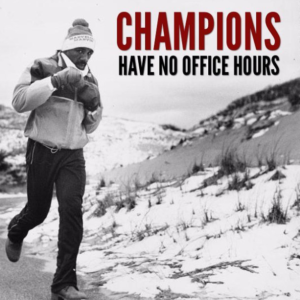 Throughout the years, I’ve been fortunate to work with several influential coaches and mentors. When I was coming up, there was a guy, Kent Ward, who was a guy that that when I was a young boxer, I fought at his gym for a little bit. He runs a boxing/MMA gym and his son is a professional MMA fighter. I think he’s probably in his 60’s now, but absolute beast as far as strength, grip strength, overall strength. He certainly had an influence on me. Pepe Vasquez is another guy who was a wrestler that I came up around. He passed away very young, only 48 years old, but he was another guy when I was younger I looked up to. He was another guy, really physical style, and a lot of calisthenics, and just a real hard mentality. There’s so many that are soft in today’s world. He was the opposite of that. As far as inspirations elsewhere, Marvin Hagler. Trained in Cape Cod, Massachusetts, ran in his work boots, lived in isolation.
Throughout the years, I’ve been fortunate to work with several influential coaches and mentors. When I was coming up, there was a guy, Kent Ward, who was a guy that that when I was a young boxer, I fought at his gym for a little bit. He runs a boxing/MMA gym and his son is a professional MMA fighter. I think he’s probably in his 60’s now, but absolute beast as far as strength, grip strength, overall strength. He certainly had an influence on me. Pepe Vasquez is another guy who was a wrestler that I came up around. He passed away very young, only 48 years old, but he was another guy when I was younger I looked up to. He was another guy, really physical style, and a lot of calisthenics, and just a real hard mentality. There’s so many that are soft in today’s world. He was the opposite of that. As far as inspirations elsewhere, Marvin Hagler. Trained in Cape Cod, Massachusetts, ran in his work boots, lived in isolation.
Yeah, I liked Marvin Hagler. He was a former Marine, a true Devil Dog.
His was the epitome of what a training camp is supposed to be like. A lot of people talk about Bernard Hopkins, like his Spartan style of camp, but Hagler was doing that before Hopkins was around and he was an absolute beast. I wanted to be like Hagler.
I just finished Jack Dempsey’s “Championship Fighting” and thoroughly enjoyed it. I’m currently reading “Physical Training Simplified” by Mark H. Berry. Do you have any books that you would recommend?
Dempsey’s another one. I’ve put a blog up about it before, where if you look back at what Dempsey recommends, it’s like so much of what he said many, many years ago, is still relevant today. He talks about boxing like the way you get in shape is through the hard shadow boxing, through the hard bag work, doing your wind sprints. It’s all stuff that’s still relevant today. Very little has changed.
It’s available on Amazon. My MMA coach recommended I get it and I’m glad I listened!
It’s a great read. When you look at stuff like that, you realize … I always say technology changes so much. I think about my own life and how the difference and technology, but you look back at guys like Walter Payton— Walter Payton’s another guy as far as early influences. Payton was a monster in the NFL, ran hills, skipped rope, real simple style of training, but he was an absolute beast. What Walter Payton was doing in the 1980’s is still just as good today as it was then. You’d be hard pressed to find a better running back ever than Walter Payton.
I like his quote, “When you’re good, you tell other people, and when you’re great, they tell you.”
Yeah, and there’s a video I’ve put up of him before when he talks talks about— they ask him about his training style, and he says— when he’s talking about the hill, there’s a famous hill he used to run, “I tried to kill myself.” I think that’s a great line. He’s pushing himself to the point of no return, and it’s like you hear it and it sounds crazy until you’ve been there. Walter Payton is definitely a big influence to me.
Some people, like you say, they don’t necessarily have the background to back up their credibility. The easiest way to get attention is to say, “Hey, that thing you’re doing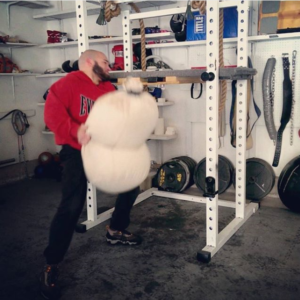 right now, that’s dangerous. Immediately, you get people’s attention. Do you think that that’s why so many people are against things like the Bent Press, the Side Press, the neck bridge, Steinborn Lifts, all these moves that were used in physical culture for hundreds of years without any injuries?
right now, that’s dangerous. Immediately, you get people’s attention. Do you think that that’s why so many people are against things like the Bent Press, the Side Press, the neck bridge, Steinborn Lifts, all these moves that were used in physical culture for hundreds of years without any injuries?
That’s definitely part of it, and I think on top of it, people don’t want to hear this, but a lot of people today, these people coming up, they’re 100% book smart with no real world experience. So someone told them it was dangerous, they believe it is dangerous. They’ve never done it. I’m not going to formulate an opinion on something that I haven’t done.
If someone asks me, “What do I do to improve my golf game?”
I’m going to tell them I don’t have a freaking clue because I don’t play golf. But, people today, they want to act like they know something about everything. Someone who’s never, ever done a neck bridge is going to look at me and tell me that’s bad for my neck. But, at the same time, that person chances are has never done anything for his neck. Neck training isn’t the most common thing on the world. If you’re not involved in wrestling or martial arts or boxing, chances are you haven’t done much for your neck. It’s like, you know what? Okay. That’s all right, but don’t waste my time with your opinion on what’s bad for your neck if you’ve never even trained your neck.
It trips me out because think of how many kids in the United States alone have trained their necks as part of youth and high school wrestling for a hundred years and you never see some old person in a neck brace because he did neck bridges as a kid!
I’m training a fighter, correct? Guess what? Fighting isn’t good for you either. But, we’re not doing it because it’s good for us. I’m building my neck up so if someone punches me in the face, I can take it a little better, or if someone pulls down on my neck, I can take it a little better. Everybody sees things and they’re just assuming … I’m not training people to just go out for health always. A lot of times the fight game is the worst thing for your health. You don’t come out the same. But, it’s like the people who are involved in the sport know that. Yeah, sure, you might build up some strength, which helps you in your life. But, at the same time, an NFL football player, look at some of the abuse they put their bodies through as a fighter. It’s not all about just health. It’s about doing what you need to do so you can be victorious.
I also say, whatever movement that I do that you call dangerous is probably as risky as holding a bar loaded to 300 plus pounds over your face while you’re immobilized on a bench with no easy way to get out of the way if your wrists straighten and it falls. Anything goes wrong and that’s just your teeth over there in the corner but nobody’s giving up bench pressing any time soon!
It’s like any time I do the wheel, if I put a video up doing anytime of standing rollout, there’s going to be someone out there who says, “Oh, well, that’s bad for your back.” You know what’s bad for your back? Being weak. Being weak’s bad. I haven’t done anything in my life that’s as dangerous as being weak. If your back is weak the wheel’s going to tell you. That doesn’t mean the wheel’s bad. That means you’re not prepared to do it. Any exercise has the potential of being dangerous. I tell people, like, you can bench 200 pounds. Now go get under 300 pounds. All of a sudden that exercise got dangerous because you can’t handle it. It has nothing to do with the exercise. It has more to do with the person, what they’re physically prepared to do. It’s easier and more convenient to blame an exercise than to look in the mirror and recognize your own ability.
Want to learn more from Ross or pick up some of his excellent books or DVD training courses? Check out rosstraining.com.
To follow Ross and see more of his inspiring training footage visit the following social media links:
Instagram: @rosstraining
Twitter: @rosstraining
Facebook: rosstraining
Google+ : Ross Enamait
YouTube: Ross Enamait

